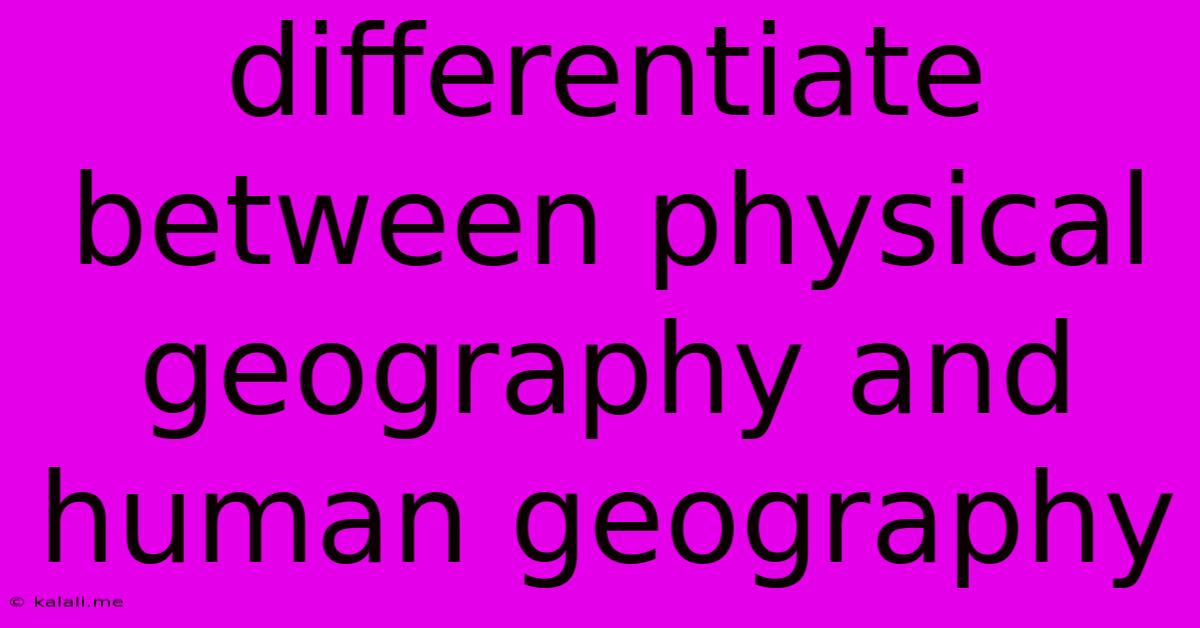Differentiate Between Physical Geography And Human Geography
Kalali
Jun 15, 2025 · 3 min read

Table of Contents
Differentiating Physical and Human Geography: Two Sides of the Same Planet
Understanding the world around us requires exploring both its natural features and the human societies that inhabit it. This is where the disciplines of physical and human geography come into play. While intertwined, they offer distinct perspectives on our planet. This article will delve into the key differences between physical and human geography, highlighting their individual focuses and the areas where they overlap. Understanding this distinction is crucial for anyone seeking a comprehensive grasp of geographical studies.
What is Physical Geography?
Physical geography focuses on the Earth's natural environment. It examines the processes and patterns shaping the planet's surface, from the smallest grain of sand to the largest mountain range. Key areas of study within physical geography include:
- Geomorphology: The study of landforms, their origin, evolution, and distribution. This involves understanding processes like erosion, weathering, and tectonic activity.
- Climatology: The study of climate patterns, including temperature, precipitation, and atmospheric circulation. Understanding climate change and its impacts is a significant aspect of this field.
- Hydrology: The study of water on Earth, encompassing rivers, lakes, oceans, and groundwater. This involves examining water cycles, flooding, and water resource management.
- Biogeography: The study of the distribution of plants and animals across the globe, exploring factors like climate, habitat, and evolution.
- Pedology: The study of soil formation, properties, and distribution. This is crucial for understanding agriculture, land use, and environmental sustainability.
- Glaciology: The study of glaciers and ice sheets, their formation, movement, and impact on landscapes and sea levels.
What is Human Geography?
Human geography, in contrast, focuses on the spatial organization of human activities and their relationship with the environment. It examines how humans interact with, modify, and are influenced by their surroundings. Key branches of human geography include:
- Population Geography: The study of population distribution, density, growth, and migration patterns. This involves analyzing demographic trends and their societal implications.
- Economic Geography: The study of the spatial distribution of economic activities, including industries, trade, and development. Understanding global economic inequalities and patterns of globalization is central to this area.
- Political Geography: The study of the spatial organization of political power, including borders, states, and international relations. This involves analyzing geopolitical conflicts and the impact of political systems on landscapes.
- Cultural Geography: The study of the spatial distribution of cultural traits, including languages, religions, and customs. This explores the impact of cultural interactions and diffusion.
- Urban Geography: The study of cities and urban areas, including their growth, structure, and function. Understanding urban planning, social inequalities within cities, and the challenges of urbanization is key.
- Environmental Geography: This branch explores the complex relationship between humans and the environment, examining issues like pollution, resource depletion, and environmental sustainability. It's where physical and human geography significantly overlap.
The Overlap: Environmental Geography and Geopolitics
While distinct, physical and human geography are not mutually exclusive. The most significant overlap occurs in environmental geography, where researchers examine the interplay between human activities and environmental processes. For example, understanding deforestation requires knowledge of both the ecological impacts (physical geography) and the socioeconomic drivers (human geography). Similarly, geopolitics combines geographical knowledge of territories and resources with an understanding of political power dynamics.
In conclusion, physical and human geography offer complementary perspectives on our world. Physical geography provides the foundation of understanding Earth's natural systems, while human geography explores the intricate relationship between humans and their environment. While distinct in their focus, they are increasingly integrated, recognizing the crucial interdependence between the natural world and human societies. By understanding both, we can gain a more holistic and nuanced understanding of our planet and its future.
Latest Posts
Latest Posts
-
Which Of The Following Attack Compromises Confidentiality Choose Two Options
Jun 16, 2025
-
According To The Law Of Supply When Prices Increases
Jun 16, 2025
-
How Many Diagonals Does A Nonagon Have
Jun 16, 2025
-
Lcm Of 2 And 3 And 6
Jun 16, 2025
-
Which Of The Following Is Not A Capital Expenditure
Jun 16, 2025
Related Post
Thank you for visiting our website which covers about Differentiate Between Physical Geography And Human Geography . We hope the information provided has been useful to you. Feel free to contact us if you have any questions or need further assistance. See you next time and don't miss to bookmark.